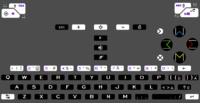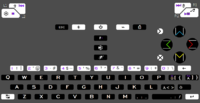Hi, I am new to this board but I've been following the development of the Pyra for a while now and I also used to own a Pandora (emphasis on _used to_). I hope to be a Pyra owner at one point in the future and therefore would like to lend my voice to the discussion. I am not sure if this has already come up so please indulge me if someone already mentioned the same things. (Translation: If I'm too late to the party, just tell me and I'll show myself out.)
My
main points are:
- leave the physical keyboard layout (QWERTY) alone as much as possible
- do not try to accomodate for language specific issues (localization) with dedicated keys (e.g. single keys for ä, ü, é, etc.)
- solve such issues with modifier keys (Fn, Alt, etc.) and in software (please see explanation below)
- try to allow for users to configure their keyboard layouts and input methods in software as much as possible
To briefly show you where I'm coming from in terms of user experience, here's a list of portable devices I've owned and used over the years (in no chronological order):
- IXI Mobile / PocketWeb OGO CT-17 and CT-25E
- HTC Universal, aka Qtek 9000/Vodafone VPA IV/T-Mobile MDA Pro (Windows Mobile 5 PocketPC)
- E-TEN Glofiish M800 (Windows Mobile 6 PocketPC)
- Nokia N900
- Nintendo DS, 3DS
Believe it or not, for me the two PocketWeb devices had the most pleasant typing experience on a portable device with a physical keyboard. Neither the Pandora nor my current Samsung smartphone allow me to type as fast and with as little hesitation as these two devices.
Based on this experience I would like to propose two solutions:
1) Allow use of a "timing based" approach for keyboard combinations for character capitalization and keyboard commands
Here's an example: You want to type a name with proper capitalization like "Alexander the Great". What you do is press the modifier key (SHIFT ) on your keyboard and then _let go of it_ and press the next key, in this case the letter (a) to be capitalized within a brief period. The result is the letter "A". The reason for this is that you only have two fingers (your thumbs -- and index fingers for shoulder buttons) and it can be awkward and clumsy having to replicate the way of typing on a desktop keyboard on a thumb keyboard. This was especially apparent on the Pandora keyboard which made it clumsy to use special characters or use common keyboard commands because of the need to "reach around" the keyboard to press several buttons _at the same time_.
The software part of this should be configurable to allow it to be turned ON or OFF (user preference) and to set a timing intervall within which the successive keys need to be pressed (#.# seconds, with a fixed maximum, e.g. maybe 1.0 second).
Another somewhat related example to this timing issue is the way you can access files in Windows Explorer (I assume it applies to other operating systems as well). Say you have a folder that contains lots of files and/or folders and you quickly want to jump to a specific file by selecting it.
Folder contents:
...
opera.*
open.*
opening.*
party.*
pat.*
patty.*
patrick.*
pet.*
pets.*
pi.*
pie.*
pies.*
post.*
...
Press "p" on your keyboard and the first file beginning with that letter will be selected. Press "p" and then quickly "e" and the selection will be the first file beginning with "pe", and so on. To my knowledge, this is practical and works for at least three letter inputs in quick succession. Therefore, I would like to argue that it is indeed a viable solution to allow keyboard commands such as the following examples by pressing the keys not at the same time like on a desktop computer but rather in quick succesion:
- SHIFT + a to get A
- SHIFT + ALT + a to get Ä
- CTRL + C to execute COPY command
- ALT + F4 to execute QUIT command
2) Regarding the input of special characters (non-ASCII)
How do current smartphones with their touchscreen based keyboards deal with this issue? They allow for standard alphabet characters on the onscreen keyboard to be pressed and then show all the available variations of those letters. So, if you press and hold (e) you get to choose from é, è, ë, etc. This is also the most logical solution: locate special characters _where_ their base characters are, so under (a) you will find à, ä, á, æ, etc. Similarly, users could be allowed to map their most frequently used special characters to a certain level of keyboard combinations, e.g.
- press (e) to get e
- press SHIFT + (e) to get E
- press ALT + (e) to get é
- press SHIFT + ALT + (e) to get É
Please do not create extra physical buttons for such cases. (US English is the superior layout.) And again, such a solution would have to be built into the software.
So, in summation, my two proposed solutions are:
1) Allow timing based character and command input.
2) Use UI and modifier keys to access non-ASCII characters.
P.S.: I may have missed this, but I hope the mouse buttons can be assigned to other keys than the analog nubs?



